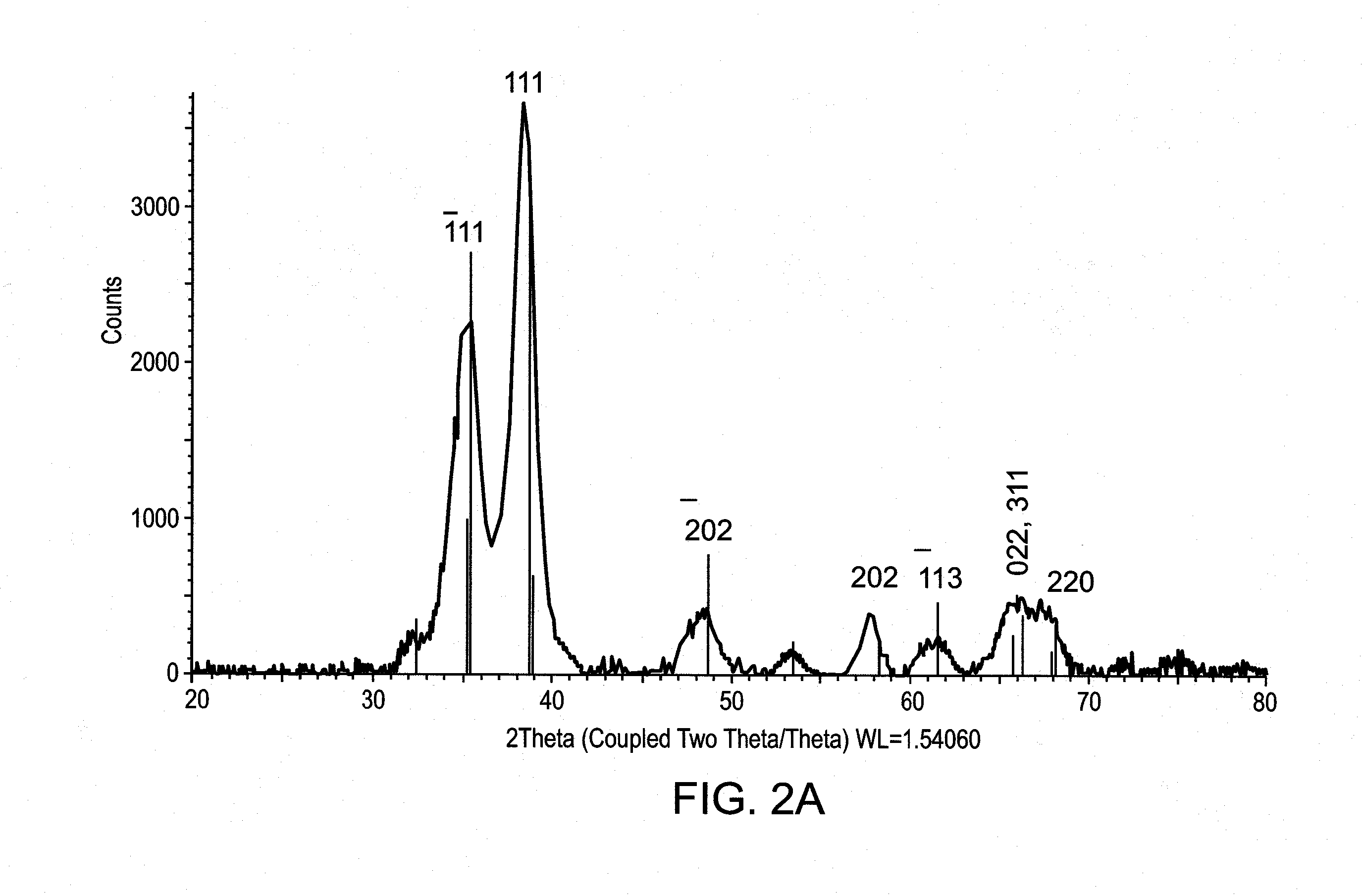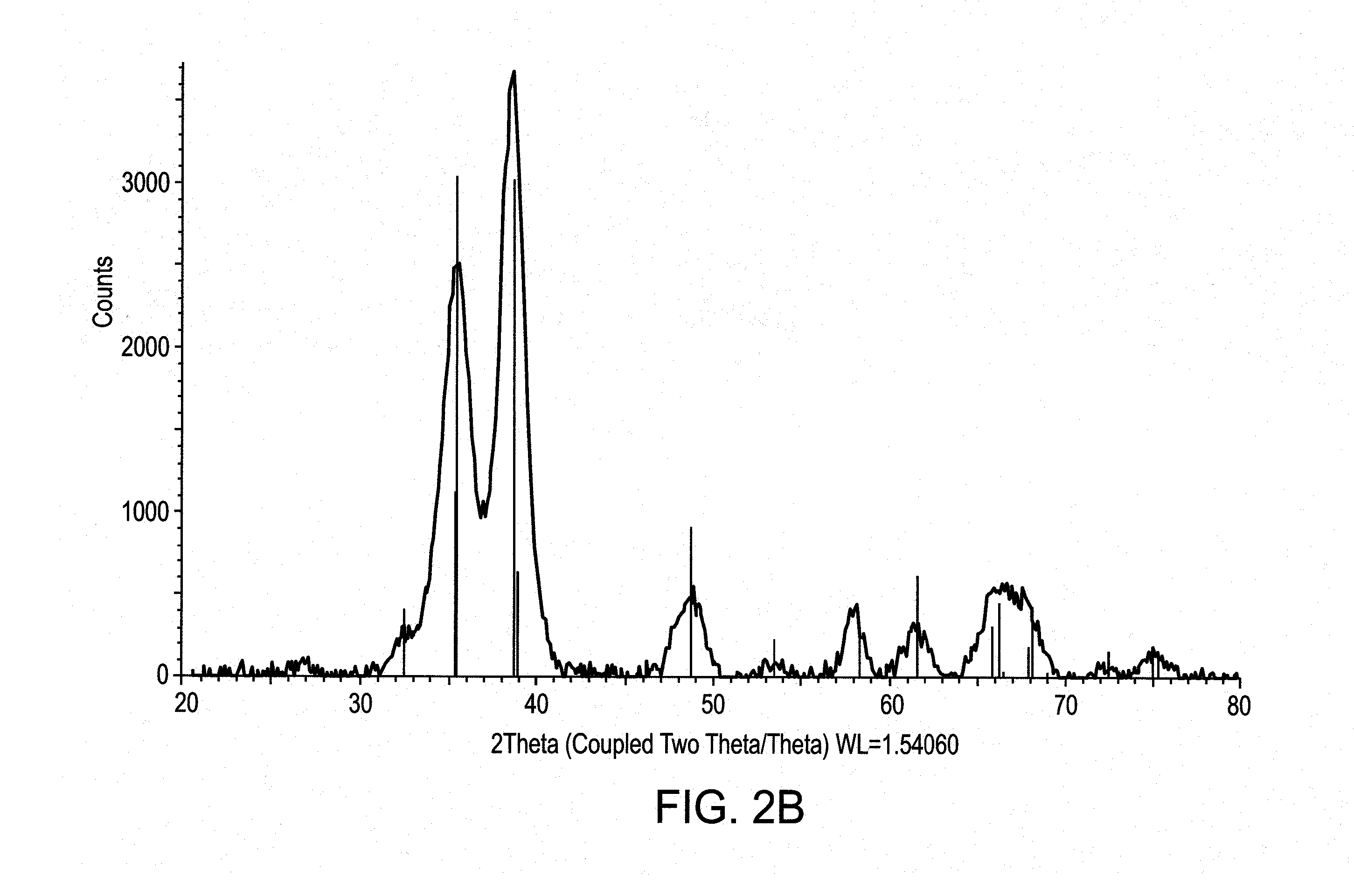Doped metal oxide nanoparticles of and uses thereof
a technology of metal oxide nanoparticles and nanoparticles, applied in the field of material science, can solve the problems of increasing the cost of antibiotic treatment, imposing a substantial burden on the medical system, and ineffectiveness in some cases, and causing patient suffering and mortality
- Summary
- Abstract
- Description
- Claims
- Application Information
AI Technical Summary
Benefits of technology
Problems solved by technology
Method used
Image
Examples
example 1
Preparation of Metal Oxide Nanoparticles
[0429]Preparation of Metal-Oxide Nanoparticles by Applying Ultrasonic Irradiation (Sonochemically-Prepared Metal Oxide Nanoparticles)—General Procedure:
[0430]A metal precursor or a mixture of a first and a second metal precursors is dissolved in water (e.g., double distilled water), ethanol is added so as to obtain a solution of e.g., 9:1 (v / v) ethanol:water, and the solution is subjected to ultrasonic irradiation using high intensity sonication (e.g., using an immersed Ti-horn, 20 kHz, 750 W at 40% efficiency, Sonics & Materials VCX600 Sonofier). After 1 to 10 minutes, an alkaline aqueous solution (e.g., 28-30% ammonia solution) is added to the sonicated reaction mixture, and the reaction vessel is maintained at 30° C. (e.g., by means of a water bath) for additional 30-60 minutes. The obtained solution is thereafter centrifuged, and the obtained nanoparticles are dried under vacuum.
[0431]In some embodiments, sonication is performed at 45 W cm...
reference example 1
[0454]A mixture of metal precursors in a concentration and molar ratio as designated hereinabove as med-3:1 Cu:Zn was obtained by dissolving 0.15 grams of Copper acetate monohydrate and 0.055 grams of Zinc acetate dihydrate in double distilled water (ddH2O; e.g., 10 ml) while stirring and thereafter adding ethanol (90 ml) to the solution so as to obtain a solution of 100 ml of 9:1 (v / v) ethanol:water. The obtained solution was subjected to microwave irradiation oven using a domestic microwave oven. After 1 minute from the beginning of the irradiation, 0.8 ml of an aqueous solution of ammonia (28-30%) was added to the reaction mixture so as to adjust the pH to about 8. Once ammonia was added, the color of the reaction mixture turned from pale blue to dark blue and then became a dark brown. After a time period of about 15 minutes, the obtained nanoparticles were cleaned of impurities and traces of ammonia by centrifugation (1000 rpm) following washing twice with double-distilled water...
reference example 2
[0455]A mixture of metal precursors in a concentration and molar ratio as designated hereinabove as med-3:1 Cu:Zn was obtained by dissolving 0.15 grams of Copper acetate monohydrate and 0.055 grams of Zinc acetate dihydrate in double distilled water (ddH2O; 10 ml) while stirring and thereafter adding Ethanol (90 ml) to the solution so as to obtain a solution of 100 ml of 9:1 (v / v) ethanol:water. The obtained solution was heated at a heating plate to 60° C. while stirring and 0.8 ml of an aqueous solution of ammonia (28-30%) was added to the reaction mixture so as to adjust the pH to about 8. Once ammonia was added, the color of the reaction mixture turned from pale blue to dark blue and then became a dark brown. The reaction was carried out for 5 hours. The obtained particles were cleaned by centrifugation (1000 rpm), washed and dried, as described hereinabove.
[0456]Preparation of Zn-Doped MgO Nanoparticles Via Ultrasonic Irradiation:
[0457]Zinc acetate dihydrate (an exemplary Zn pre...
PUM
| Property | Measurement | Unit |
|---|---|---|
| Diameter | aaaaa | aaaaa |
| Molar density | aaaaa | aaaaa |
| Molar density | aaaaa | aaaaa |
Abstract
Description
Claims
Application Information
 Login to View More
Login to View More - R&D
- Intellectual Property
- Life Sciences
- Materials
- Tech Scout
- Unparalleled Data Quality
- Higher Quality Content
- 60% Fewer Hallucinations
Browse by: Latest US Patents, China's latest patents, Technical Efficacy Thesaurus, Application Domain, Technology Topic, Popular Technical Reports.
© 2025 PatSnap. All rights reserved.Legal|Privacy policy|Modern Slavery Act Transparency Statement|Sitemap|About US| Contact US: help@patsnap.com



